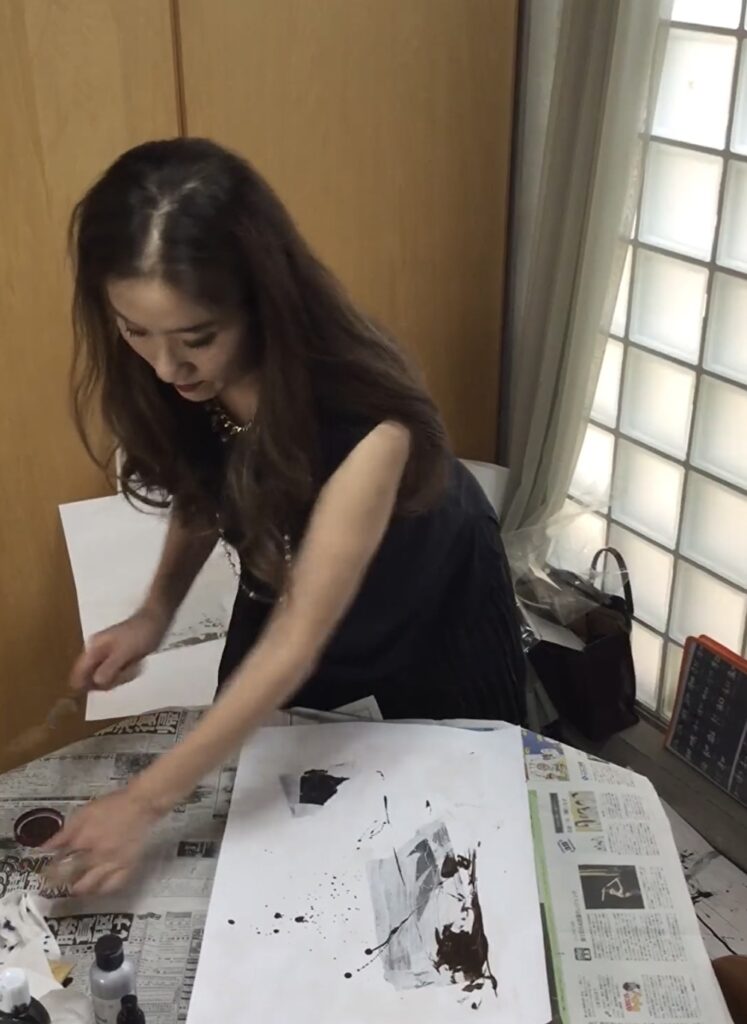
Mami Kawasaki is a Japanese Artist
Mami transcends the Japanes tradition of Calligrrphy and work on paper, nringing ii in the 21st century
Remarkable Artworks


Biography
Mami Kawasaki grew up under the strict guidance of her mother in a cultural environment of traditional Japanese performing arts such as Japanese dance, flower arranging, and the tea ceremony. At his father’s family home, he helped tend the Japanese garden and admired the seasonal hanging scrolls by Yokoyama Taikan and Tomioka Tessai that his grandfather had collected. Because she grew up in an environment with a rich sense of sensibility and a high sense of beauty, she was probably able to appreciate the beauty of the four seasons and the beauty of Japan.
In 1967, she learned calligraphy, but was not good at practicing imitation. But she gradually became fascinated by the flowing lines of cursive. During her junior college days, she learned “kana characters” and was drawn to the world of history, composition, elegance, and beautiful brushstrokes, and in 1981 she began to study calligraphy in earnest.
In 1995, she turned to graphic design, exploring the expression of text and non-text elements. Eventually, he was introduced to the world of ink painting and the avant-garde, and improved his skills. During this time, she realized that the rhythm and timing of using sumiink can be a form of personal expression, and she turned to abstract painting.
Since 2012, she has won numerous awards in the painting category and established his own unique technique. She has also experimented with materials other than paper, such as metal and plastic. She also researched the possibilities and effects of sumiink, blending it with volatile substances and incorporating it into her works. my art combines the melancholic nature of sumiink with the expressive depth of Eastern mysticism, leaving a deep impression and lingering impression on the viewer.
Due to the blockade of Covid-19 in 2020, mami kawasaki solo exhibition in New York was postponed. She began painting landscapes from that time. I conveys the symbolic value of sumiink in terms of melancholy, nostalgia, and lyricism, and embodies the concept of “rebirth and revival” that has become a spiritual pillar of my art.
The 2023 NY Artery Gallery solo exhibition was a success, many visitors praised the art, the exhibition was extended, and the exhibition received a review in ARTERY Magazine http://arterynyc.com/.
2012-13 Japan-Korea Painting Exchange Meeting (seongnam art center Museum)
2013 Calligraphy and Non-CalligraphyBeijing Exhibition
Busan Calligraphy Biennale
Tokyo Spiral Art Fair + Prius.Ultra
2015-19 All Kansai Art Exhibition 2nd/3rd Prize
2017 Nishinomiya City Exhibition Grand Prix
Mihama Art Exhibition
2018 Ueno Royal Museum Grand Prize Exhibition
Hyogo Prefectural Harada Forest Museum Solo Exhibition
2019 Art Olympia, 2019 Excellence Award
Los Angeles Art Open Call “LJA”
2020 Italy Mega Art Exhibition “The Journey of art”
2021 Rome MO.C.A gallery exhibition「Alla ricerca della bellezza」
2022 BIENNNALEdelGATTOPARDO
2023 NYC ”gallery artifact” Planned Solo Exhibition 11/1-11-12
Pier94 NY Art EXSPO
Paris.Art Capital Exhibition
Italy. Colle del Dumo Museum Venice. Venice Gallery
Italy.AIAP Exhibition
2024 Dubai Picasso Gallery Exhibition
Paris.Art Capital Exhibition

Statement
Artistic Expression
My artistic expression through painting starts with understanding the compatibility between washi (Japanese paper) and sumi (ink) and familiarizing myself with their respective characteristics. Despite being referred to as black, sumi can display various expressions. To extract different elements from its allure, I dilute and layer it to create textures, exploring the possibilities it offers when combined with other art materials. From these seemingly trivial processes, essential elements that need to be transformed into images are extracted. Through Japan as a conduit, I hope to make people aware of and understand the art of harnessing the power of sumi to evoke human emotions and sentiments. Evolution and regression, preservation and abandonment…the essence lies within what is forgotten and discarded.
In the creative process, I rarely use a brush. I often use a palette knife as a substitute for a brush, experimenting with angles and syringes to create sharp lines. I also spray or dab ink diluted with a spray bottle. Repeating the process of changing the density and drying the ink creates depth and evokes a lyrical effect. He draws many elements from nature, such as using tea and coffee as painting materials. He makes pens from reeds and plant roots found by the river. A mixture of carbon and glue and a powder made from crushed seashells are also made using his original recipes. Years of experience and intuition play an important role in these operations.
Individuals who have influenced the artistic expression of lines and characters in my paintings include Yuuzou Saeki, Tuguharu Fujita, Jackson Pollock, Robert Rauschenberg, and Toko Shinoda. The thin and continuous flowing lines, with variations incorporated into landscapes and canvases, are based on the extension of “kana” characters that originated in the Heian period. This effect characterizes my works. By consciously paying attention to the invisible elements present in light, water, rain, wind, and nature, and deciphering their aromas, I establish connections with past events and embark on the creative process through my five senses.
statement
”Invisible fish cannot be caught.” These were the words my father said in response to my childhood question about why we can’t catch the fish swimming beneath the breakwater. You cannot catch fish that can see through people’s hearts. In art, it is important to introspect and analyze how to express the unseen aspects, starting with self-reflection and dialogue. My starting point lies in exploring and expressing the thoughts and emotions deep within my own heart that cannot be summoned by words alone. Through this realization, I began incorporating sumiink into my abstract and landscape paintings, recognizing its importance as something beyond a mere tool to mitigate the influence of words. My experiences gained from the past fuse with art and transcend time. They allow me to extract the eternal from the transient, evoke memories, and present the audience with a poetic visual expression of empathy.
Press
Coming soon
